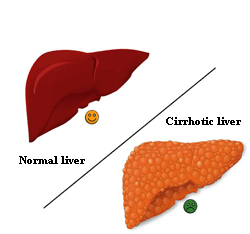for Veterans and the Public
What is cirrhosis? - Cirrhosis for Patients
When something attacks and damages the liver, liver cells die and scar tissue is formed. This scarring is called fibrosis (pronounced “fi-bro-sis”), and it happens little by little over many years. When the entire liver is scarred, it shrinks and gets hard. This is called cirrhosis, and usually this damage cannot be undone. The liver is a unique organ and has the ability to regenerate (make its own new healthy tissue) but after development of too much scar tissue it will lose its ability to do so.

Any illness that affects the liver over a long period of time may lead to fibrosis and, eventually, cirrhosis. Heavy alcohol drinking and viruses (like hepatitis C or hepatitis B) are common causes of cirrhosis. However, there are other causes as well. A buildup of fat in the liver, called fatty liver disease, may lead to cirrhosis. Fatty liver disease may develop in people who are overweight and those with diabetes. Some people inherit genes for certain conditions that cause liver disease, such as genes that will cause iron buildup in the liver. In other diseases, bile collects in the liver and causes damage that can lead to cirrhosis. Other causes include certain prescribed and over-the-counter medicines, environmental poisons, and autoimmune hepatitis, a condition in which a person’s own immune system attacks the liver.




















